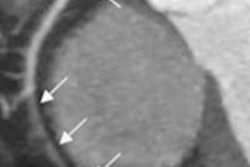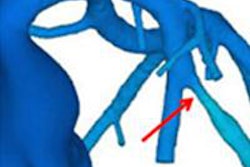Dear AuntMinnie Member,
The PET radiopharmaceutical Pittsburgh Compound B (PiB) has an affinity for beta-amyloid deposits in the brain, which can be useful for the early detection of Alzheimer's disease. But British researchers have found that the radiotracer may also be useful for detecting signs of traumatic brain injury (TBI).
As with Alzheimer's, traumatic brain injury can lead to the buildup of beta-amyloid deposits in the brain. But it hasn't been possible to quantify amyloid binding in living people, making it difficult to understand the connection between TBI and amyloid.
The researchers used PiB-PET postmortem to assess amyloid buildup in a small group of subjects who had moderate to severe TBI, comparing this group with healthy, living controls with no signs of neurological abnormalities. They found that subjects with TBI had greater PiB distribution volumes in certain areas of the brain.
Learn more about the study by clicking here, or visit our Molecular Imaging Digital Community at molecular.auntminnie.com.
More Birnholz on ultrasound
Dr. Jason Birnholz is back in our Ultrasound Digital Community with another of his popular articles on advanced clinical applications for ultrasound.
His current column covers the use of ultrasound for liver fat and fibrosis, an increasingly urgent topic given the rise of obesity in many Western countries. Dr. Birnholz sees ultrasound as being uniquely suited for these applications, although he has some advice for users on how they can tweak their scanners to get the most out their technology.
For example, he offers an inexpensive solution for improving the diagnostic return of 2D ultrasound images, one that's as simple as downloading some open-source software. Find out how it works by clicking here, or visit our Ultrasound Digital Community at ultrasound.auntminnie.com.
CCTA less than 1 mSv
Routine coronary CT angiography (CCTA) scanning at less than 1 mSv of radiation dose has been a holy grail for CT practitioners. In a new article in our CT Digital Community, researchers from the U.S. and China explain how they do it using an advanced iterative reconstruction protocol.
The research team scanned stable patients from small to large using both low and ultralow dose levels, followed by conventional angiography. They then reconstructed the CT images using conventional filtered back projection as well as iterative reconstruction. Calculating both radiation dose reduction and diagnostic image quality, they compared the techniques against the gold standard, invasive coronary angiography.
One novel thing about the study was that patients were scanned twice -- long a no-no for ethical reasons due to the doubled radiation dose. But with doses well under 1 mSv, such techniques are possible.
Find out what they learned by clicking here, or visit the community at ct.auntminnie.com.




















